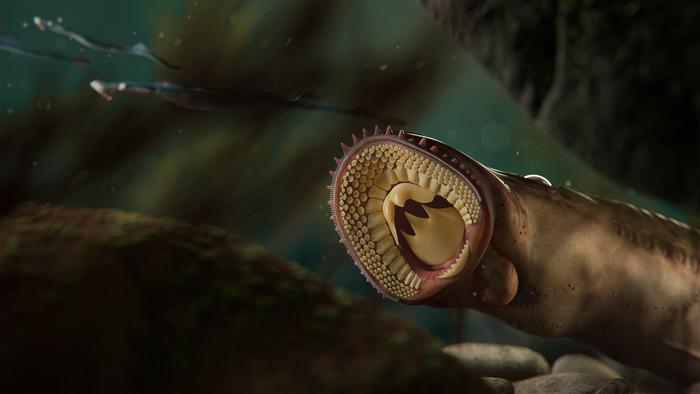Researchers from the Institute of Vertebrate Paleontology and Paleoanthropology (IVPP) of the Chinese Academy of Sciences and their collaborators have reported two extremely rare fossil lampreys from the Jurassic of northern China and revised our understanding of lamprey evolution.

Credit: NICE Vistudio
Researchers from the Institute of Vertebrate Paleontology and Paleoanthropology (IVPP) of the Chinese Academy of Sciences and their collaborators have reported two extremely rare fossil lampreys from the Jurassic of northern China and revised our understanding of lamprey evolution.
The study was published in Nature Communications on Oct. 31.
The precious specimens were discovered in the famed Lagerstätte Yanliao Biota from rocks dating back 158–163 million years. One of them, Yanliaomyzon occisor or “Yanliao sucker killer,” is 642 mm long (about 25 inches) and is the largest fossil lamprey ever found.
Both fossils superbly preserve the lampreys’ keratinous teeth. After carefully examining the fossils, the scientists reinterpreted lamprey evolution, particularly their feeding apparatus, life cycle, and historic biogeography.
The Jurassic fossils’ feeding apparatus strikingly resembles that of the living pouched lamprey Geotria australis, a flesh-feeding species. “Our study resolved these Jurassic lampreys as the closest fossil relatives to extant lampreys,” said WU Feixiang, lead author of the study.
“Contrary to conventional wisdom that modern lampreys’ ancestors fed on blood, our study showed that these two Jurassic lampreys must be flesh eaters, which foreshadows the flesh-eating habit of the most recent common ancestor of modern lampreys,” added WU.
The study also recognized the Jurassic as a watershed in lamprey evolutionary history.
During the earlier Paleozoic era, lampreys may not have been predacious like their living relatives. This is based on consideration of Paleozoic lampreys’ dwarfed body size and weak, simply assembled teeth. Furthermore, most other contemporaneous ancient fishes were heavily armored—with hard scales and body covers that prevented these tiny lampreys from biting through. However, as the abundant emergence of the ‘advanced’ teleost fishes with thinned scales since the Early Jurassic—changes that increased food availability—lampreys also changed.
“The abundant emergence of advanced teleost fishes with thinned scales by the Early Jurassic might have provided an important evolutionary opportunity for lampreys,” said WU. “With the enhanced feeding structures, Jurassic lampreys onward were able to grow sufficiently large to meet the energy requirement of the evolution of a ‘prolonged’ life cycle interposed by the metamorphosis stage and involved in dramatic environmental shifts.”
A time-calibrated family tree is the basis of an evolutionary history narrative. Inference of the time tree for lamprey evolution was performed in a Bayesian total-evidence dating framework. “Compared with the parsimony method, Bayesian inference is able to integrate various sources of information in a probabilistic setting while accounting for the uncertainties of the parameters, thus avoiding ad-hoc determinations and partial use of the data,” said ZHANG Chi, another corresponding author of the study.
This method also makes possible the inference of ancestral geographical areas for lampreys. The history of the anti-tropical distribution pattern of lampreys has baffled biogeographers due to the extremely thin fossil record of the group. With the calibrations of the Jurassic lampreys, the lineage of the pouched lamprey in the Southern Hemisphere was resolved as the earliest diverged lineage among living lampreys. Thus, the study estimates that modern lampreys originated in the Southern Hemisphere during the Late Cretaceous. This contradicts the conventional wisdom that lampreys originated in the Northern Hemisphere, where most extant lamprey species live.
“This discovery clearly indicates that the extant southern lampreys retain a feeding morphology that already arose in the Jurassic, and that modern lamprey phylogeny is now consistent with a Southern Hemisphere origin, combined with an adaptation to a carnivorous diet,” said Prof. Philippe JANVIER of France’s National Museum of National History, a co-author of the study.
Although large gaps in the long evolutionary history of lampreys still exist, the discovery of Jurassic lamprey fossils is expected to promote more research in the future.
Journal
Nature Communications
DOI
10.1038/s41467-023-42251-0
Article Title
The rise of predation in Jurassic lampreys
Article Publication Date
31-Oct-2023




